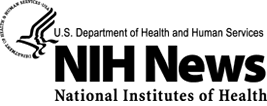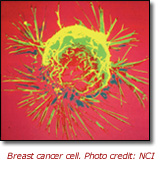Last updated: July 24, 2012
New Findings Offer More Complete View of Breast Cancer Gene Mutations in U.S. Population

New Findings Offer More Complete View of Breast Cancer Gene Mutations in U.S. Population
NIH-Supported Study Among The First to Include African Americans, Older Women
 BETHESDA, Md., Tues., Aug. 15, 2006 — A large study funded by the National Institutes of Health today provided the clearest picture yet of the prevalence in the U.S. population of mutations in two genes associated with an increased risk of breast cancer. The genes are called Breast Cancer 1 (BRCA1) and Breast Cancer 2 (BRCA2). In addition, the study identified key predictors for assessing which women are most likely to carry these genetic mutations.
BETHESDA, Md., Tues., Aug. 15, 2006 — A large study funded by the National Institutes of Health today provided the clearest picture yet of the prevalence in the U.S. population of mutations in two genes associated with an increased risk of breast cancer. The genes are called Breast Cancer 1 (BRCA1) and Breast Cancer 2 (BRCA2). In addition, the study identified key predictors for assessing which women are most likely to carry these genetic mutations.
Each year, approximately 200,000 women in the United States are diagnosed with breast cancer. The majority of breast cancer cases are caused by genetic changes that occur during a woman's lifetime and not by genetic mutations inherited from her parents. However, researchers estimate that inherited mutations play a role in anywhere from 5 to 27 percent of all breast cancer cases. In the mid 1990s, researchers found that mutations in the BRCA1 and BRCA2 genes are a major cause of the hereditary form of the disease. Women inheriting these mutations have a 40 to 85 percent lifetime risk of developing breast cancer, as well as an increased risk of ovarian cancer.
To date, most of the studies on BRCA1 and BRCA2 mutations have focused on families known to be at high risk for breast cancer and on women who develop breast cancer at a relatively young age. The new study, published today in the journal Cancer Research, looked at the prevalence and predictors of BRCA1 and BRCA2 mutations in under-studied groups of women, such as African Americans and older women.
"Studies of any notable size have focused almost exclusively on white women and young women. This research clearly was needed to improve our means of assessing the likelihood of carrying BRCA1 and BRCA2 mutations in a wider spectrum of women," said one of the study's lead investigators, Elaine Ostrander, Ph.D., chief of the Cancer Genetics Branch in the National Human Genome Research Institute's Division of Intramural Research. Dr. Ostrander was previously head of the genetics program at the Fred Hutchinson Cancer Research Center, which is the institution that led the study.
The researchers examined the prevalence and predictors of BRCA1 and BRCA2 mutations in 1,628 women with breast cancer and 674 similar women without breast cancer, all of whom were participants in the National Institute of Child Health and Human Development's (NICHD's) Women's Contraceptive And Reproductive Experiences (CARE) study. The women involved in the study were white and African American women, ages 35 to 64, who lived in the Atlanta, Detroit, Los Angeles, Philadelphia and Seattle metropolitan areas.
"The advantages of this study include its large sample size, inclusion of under-studied groups of women and the fact that the results are population based," said one of the study's co-authors, Robert Spirtas, Dr.P.H, former chief of NICHD's Contraception and Reproductive Health Branch and now retired.
Researchers found that 2.4 percent of the breast cancer patients had BRCA1 mutations and 2.3 percent had BRCA2 mutations. BRCA1 mutations were more common among white breast cancer patients (2.9 percent) than among African American patients (1.4 percent). Breast cancer patients of Jewish ancestry were also significantly more likely to have BRCA1 mutations than non-Jewish patients - 10.2 percent compared to 2.0 percent. For BRCA2, African American patients were slightly more likely to have mutations, 2.6 percent, than were white patients, 2.1 percent.
Based on their findings, the researchers went on to calculate the prevalence of BRCA1 and BRCA2 mutations in the general U.S. population. Among white and African American women ages 35 to 64, the prevalence of BRCA1 mutations is 0.06 percent and the prevalence of BRCA2 mutations is 0.4 percent, the researchers estimated.
"These findings from our large, population-based study are compatible with earlier estimates made by extrapolating from smaller studies. However, we found a slightly lower frequency of BRCA1 mutations and a higher frequency of BRCA2 mutations," said the study's other lead investigator, Kathleen Malone, Ph.D., Member of the Public Health Sciences Division at the Fred Hutchinson Cancer Center. "We think the difference lies in the fact that earlier studies were confined mainly to whites, and that African American women carry BRCA2 mutations more often than white women."
The researchers also identified key predictors of whether a woman with breast cancer is likely to carry a BRCA1 or BRCA2 mutation. Such information is important because it can help to improve means of assessing which women may benefit the most from genetic testing, increased breast cancer screening and other measures aimed at early detection, treatment or prevention. The most significant predictors for BRCA1 mutations were: Jewish ancestry, a family history of ovarian cancer and a family history of breast cancer occurring before age 45.
For BRCA2 mutations, researchers uncovered fewer predictors, and they had more modest effects. Among the breast cancer patients studied, the only significant predictors of a BRCA2 mutation were early age of onset (before age 45) in the patient herself or early onset of breast cancer in mother, sisters, grandmothers or aunts.
"These findings underscore why women need to learn as much as they can about their family health history and then share that information with their health-care professionals. However, it must be emphasized that the presence or absence of a predictive factor does not automatically equate with a high or low likelihood of carrying a breast cancer gene mutation," said NIH Director Elias A. Zerhouni, M.D. "The majority of women with breast cancer - even those with a family history of the disease - do not carry mutations in these genes. These predictors need to be considered in the context of each woman's complete family health history."
In addition to the Fred Hutchinson Cancer Center, NHGRI and NICHD, the team included researchers from the National Cancer Institute; Bay State Medical Center, Springfield, Mass.; the University of Pennsylvania, Philadelphia; University of Southern California, Los Angeles; and Wayne State University, Detroit.
About NIH
The National Cancer Institute, the National Institute of Child Health and Human Development, and the National Human Genome Research Institute are among the 27 institutes and centers that make up the National Institutes of Health (NIH) — The Nation's Medical Research Agency. NIH is a component of the U. S. Department of Health and Human Services (HHS). It is the primary federal agency for conducting and supporting basic, clinical, and translational medical research, and it investigates the causes, treatments, and cures for both common and rare diseases. For more information about NIH and its programs, visit www.nih.gov.
How to Create a Family Health History
To help people in the task of creating their family health histories, HHS offers a free, computerized tool that organizes health information into a printout that can be can taken to health-care professionals. The tool, called "My Family Health Portrait," is available at https://familyhistory.hhs.gov.
Contact:
Geoff Spencer
NHGRI
spencerg@mail.nih.gov
Robert Bock
NICHD
(301) 496-5133
bockr@mail.nih.gov
Kristen Woodward
Fred Hutchinson Cancer
Research Center
(206) 667-5095
kwoodwar@fhcrc.org
